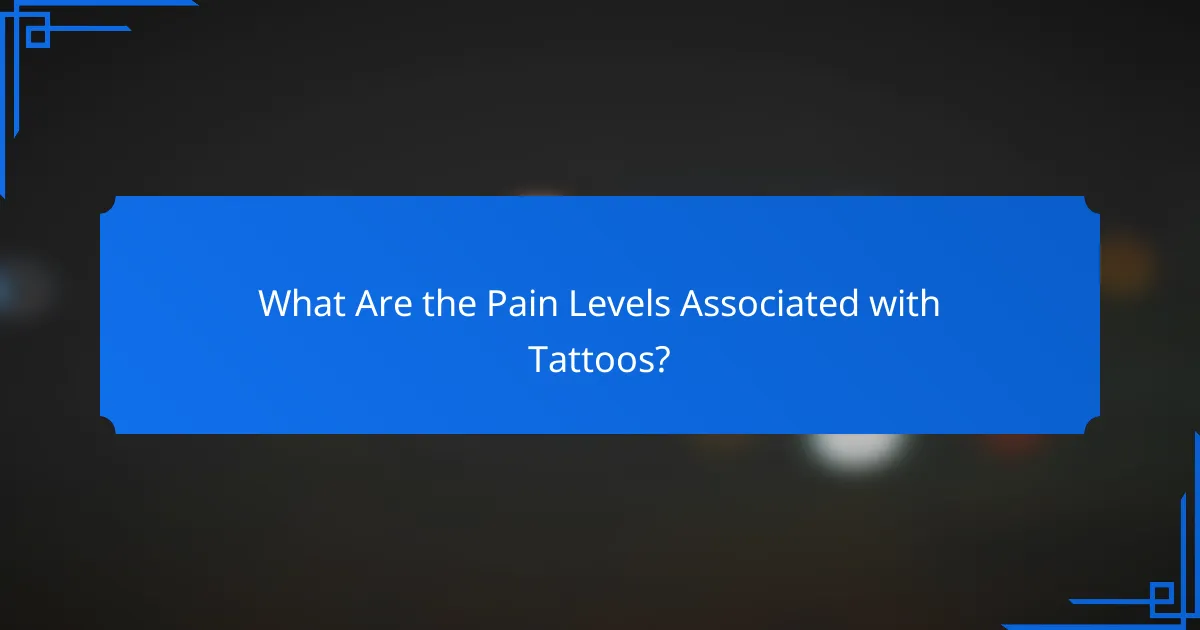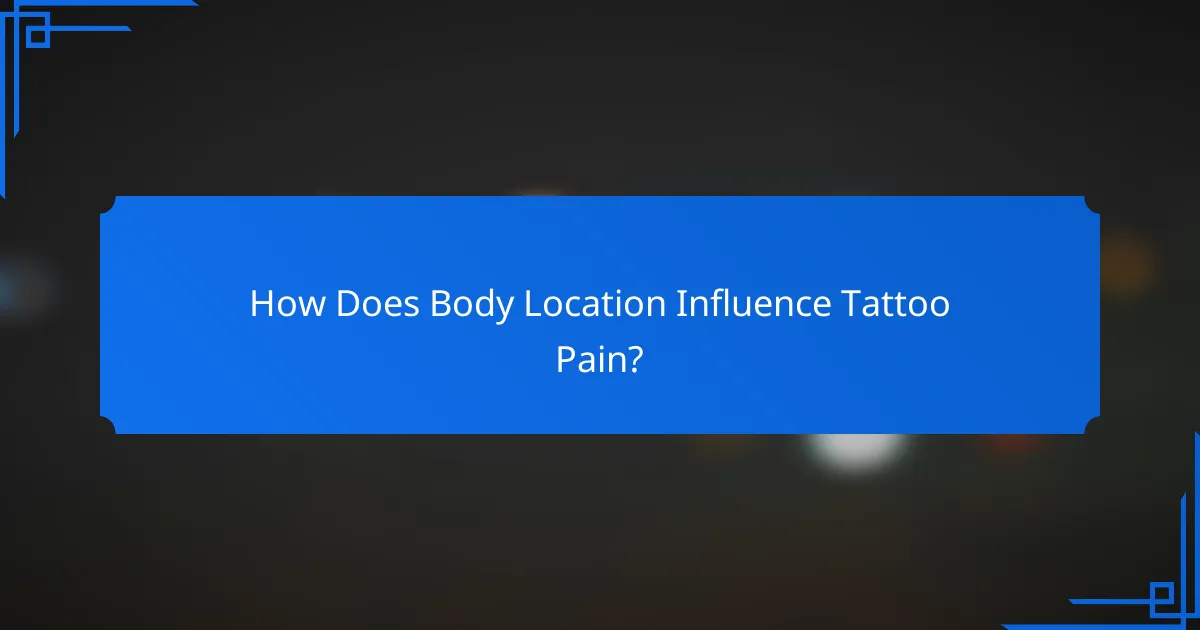Tattoo pain levels can differ greatly depending on factors such as the tattoo’s location, the individual’s pain tolerance, and the technique employed by the artist. By understanding these variables, you can set realistic expectations for your tattoo experience. Additionally, effective pain management strategies can help minimize discomfort and enhance your overall satisfaction with the process.

What Are the Pain Levels Associated with Tattoos?
Tattoo pain levels vary significantly based on the location of the tattoo on the body, individual pain tolerance, and the tattooing technique used. Generally, pain can be categorized into low, moderate, and high levels, which can help individuals set realistic expectations before getting inked.
Low pain areas
Low pain areas are typically those with more flesh and fewer nerve endings. Common locations include the outer arms, thighs, and calves. Many people report a mild discomfort in these areas, often likening it to a light scratching sensation.
For those concerned about pain, these regions are ideal for first tattoos, as they provide a more manageable experience. The skin here is thicker, which can help dull the sensation during the tattooing process.
Moderate pain areas
Moderate pain areas include regions with less flesh and more nerve endings, such as the shoulders, upper back, and stomach. Individuals may experience a sharper sensation, often described as a burning or stinging feeling. This level of pain is usually tolerable but can vary based on personal pain thresholds.
Choosing a moderate pain area for a tattoo may require some mental preparation, especially for those who are more sensitive to pain. It’s advisable to take breaks during the session if needed, to manage discomfort effectively.
High pain areas
High pain areas are those with thin skin, many nerve endings, or close proximity to bone, such as the spine, ribs, and feet. Tattoos in these locations can be intensely painful, often described as sharp or excruciating. Individuals may find it challenging to remain still during the process.
For those considering tattoos in high pain areas, it’s crucial to mentally prepare and possibly discuss pain management options with the tattoo artist, such as breaks or numbing creams. Understanding this can help set realistic expectations and reduce anxiety.
Factors influencing pain levels
Several factors influence the pain levels associated with tattoos, including individual pain tolerance, the tattoo’s size and complexity, and the skill of the tattoo artist. Each person’s experience can differ significantly based on these elements.
Additionally, factors like the time of day, hydration levels, and even mood can affect how pain is perceived. Staying well-hydrated and relaxed can help mitigate discomfort during the tattooing process.

How Can You Manage Tattoo Pain?
Managing tattoo pain involves using various techniques and products to minimize discomfort during the tattooing process. Effective pain management can enhance your overall experience and help you achieve the desired results with less stress.
Topical numbing creams
Topical numbing creams are designed to reduce pain by blocking nerve signals in the skin. These creams typically contain active ingredients like lidocaine or benzocaine and can be applied before the tattoo session to numb the area. It’s essential to follow the instructions carefully and consult with your tattoo artist to ensure compatibility with their techniques.
When selecting a numbing cream, look for products that are specifically formulated for tattoo use. Some artists may have preferred brands or recommendations based on their experience, so don’t hesitate to ask for guidance.
Distraction techniques
Distraction techniques can effectively help manage tattoo pain by shifting your focus away from the sensation. Common methods include listening to music, watching videos, or engaging in conversation with friends or the tattoo artist. These activities can make the experience more enjoyable and less daunting.
Consider bringing headphones or a portable device to keep yourself entertained during the session. Additionally, practicing mindfulness or visualization techniques can further enhance your ability to cope with discomfort.
Breathing exercises
Breathing exercises are a simple yet powerful way to manage pain during a tattoo session. Deep, controlled breathing can help calm your nervous system and reduce the perception of pain. Techniques such as inhaling deeply through the nose and exhaling slowly through the mouth can be particularly effective.
Before your appointment, practice these exercises to become familiar with them. During the tattooing process, focus on maintaining a steady rhythm to help keep anxiety at bay and promote relaxation.
Aftercare products
Aftercare products play a crucial role in the healing process and can help alleviate discomfort after getting a tattoo. Look for gentle, fragrance-free moisturizers or specialized tattoo aftercare ointments that promote healing and reduce irritation. These products can soothe the skin and minimize itching as it heals.
Follow your tattoo artist’s aftercare instructions closely and apply the recommended products consistently. Proper aftercare not only aids in healing but can also enhance the vibrancy and longevity of your tattoo.

What Factors Affect Tattoo Pain Levels?
Tattoo pain levels can vary significantly based on several factors, including individual skin sensitivity, the size and detail of the tattoo, its location on the body, and the technique used by the artist. Understanding these elements can help you set realistic expectations and manage discomfort during the tattooing process.
Skin sensitivity
Skin sensitivity plays a crucial role in how much pain a person experiences during a tattoo session. Individuals with naturally sensitive skin may find the process more uncomfortable compared to those with tougher skin. Factors such as allergies, skin conditions, and even hormonal changes can influence sensitivity levels.
To gauge your skin’s sensitivity, consider testing a small area with a temporary tattoo or a similar application. If you have known sensitivities, communicate this with your tattoo artist beforehand to discuss pain management options.
Tattoo size and detail
The size and intricacy of a tattoo directly affect pain levels. Larger tattoos or those with fine details typically require longer sessions and more extensive work, which can lead to increased discomfort. Smaller, simpler designs may be quicker and less painful.
When planning your tattoo, think about the design’s complexity and how long the session might last. If you’re concerned about pain, you might opt for a smaller piece or break larger designs into multiple sessions.
Location on the body
The location of the tattoo on your body significantly impacts pain levels. Areas with more muscle and fat, such as the upper arm or thigh, tend to be less painful, while regions with less padding, like the ribs, spine, or ankles, can be much more sensitive.
Consider your pain tolerance when choosing a location. If you’re unsure, consult your artist for advice on the best spots for your desired design, especially if you’re new to tattoos.
Artist technique
The technique employed by the tattoo artist can greatly influence the level of pain experienced. Experienced artists often have a gentle touch and efficient methods that minimize discomfort. Conversely, less skilled artists may cause more pain due to inconsistent pressure or technique.
Research your artist’s style and reviews before making an appointment. A well-reviewed artist with a reputation for being attentive to client comfort can make a significant difference in your overall experience.

What Are Common Expectations for Tattoo Pain?
Common expectations for tattoo pain vary widely among individuals, but most people describe it as a sharp, stinging sensation. Factors such as the tattoo’s location, size, and the individual’s pain tolerance play significant roles in the overall experience.
First-time tattoo experiences
First-time tattoo experiences often come with heightened anxiety about pain levels. Many newcomers report that the initial sting is more intense than they anticipated, but it typically becomes more manageable as the session progresses. Understanding that pain is temporary can help ease the nerves.
Choosing a less sensitive area for the first tattoo, such as the outer arm or thigh, can also reduce discomfort. It’s advisable to communicate openly with the tattoo artist about any concerns regarding pain.
Comparisons with other pain experiences
Many people compare tattoo pain to other common experiences, such as getting a flu shot or experiencing a scrape. While the pain from a needle can be sharp, it usually lasts only for the duration of the tattooing process. Some describe it as similar to a strong sunburn or a cat scratch.
Understanding these comparisons can help set realistic expectations. Pain tolerance varies, so what feels intense to one person may be mild to another.
Long-term pain management
After getting a tattoo, managing any lingering discomfort is crucial for a smooth healing process. Over-the-counter pain relievers, such as ibuprofen, can help alleviate pain and reduce inflammation. Applying a soothing ointment recommended by the tattoo artist can also aid in recovery.
It’s important to follow aftercare instructions carefully to prevent complications. Avoiding sun exposure and keeping the tattoo clean and moisturized can minimize discomfort and promote healing.

How Does Body Location Influence Tattoo Pain?
The location of the body where a tattoo is applied significantly affects the level of pain experienced during the process. Areas with less muscle and more nerve endings tend to be more sensitive, leading to higher pain levels.
Areas with more muscle
Tattooing on areas with more muscle generally results in lower pain levels compared to bony or highly sensitive regions. Muscles provide a cushion that absorbs some of the discomfort from the needle.
For instance, the upper arm or thigh, which are muscular areas, typically allow for a more tolerable tattooing experience. In contrast, areas like the ribs or spine, which have less muscle and are closer to bone, can be much more painful.
When considering a tattoo, it’s wise to choose a location with ample muscle if you’re concerned about pain. However, personal pain tolerance varies, so it’s essential to keep that in mind when selecting a spot for your tattoo.


